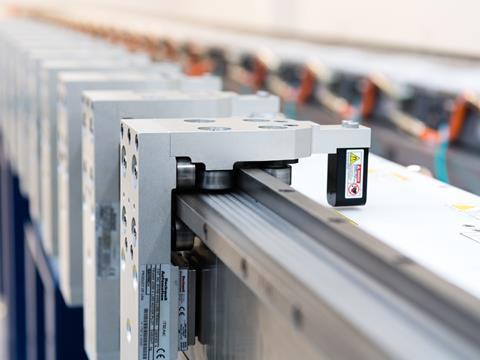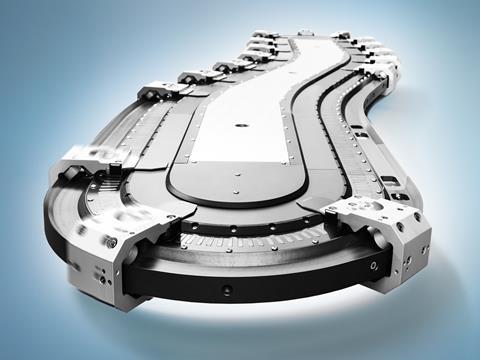
Victoria Hattersley looks at two of the leaders in smart track technologies to find out how they are enabling FMCG producers to improve flexibility, cut costs and handle the ever-increasing amounts of production data that needs to be processed.
With so much data to be analysed, consumer preferences for more highly personalised products and requirements for ever-faster turnaround times, the demands placed on production have never been higher. When it comes to conveying, smart track technologies are increasingly replacing traditional mechanical conveyors as a way to address the key challenges of today’s fast-paced industrial world.
Using smart technologies, the traditional rotary-driven chains, belts and gears are replaced by software that can offer ever-more options in terms of speed, flexibility, efficiency, safety and sustainability.
Data handling and efficiency
One of the key advantages of such technologies is data collection. “A characteristic of smart conveying is better knowledge of the items being conveyed (location, process step, quality),” says Ulrich Arlt, EMEA business manager Motion Control at Rockwell Automation. “That knowledge enables flexible processes which can reduce waste, improve quality, and can be harnessed to efficiently create new products or rapidly change to higher selling variants. The connected enterprise – the term we prefer in place of ‘Industry 4.0’ – is a part of this because it means you have all the data in the controller available in one place.”
As many of our readers will be aware, Rockwell Automation has one of the industry’s broadest portfolios of Independent Cart Technology. Its range includes the iTRAK closed-looped system and open-loop systems like MagneMover LITE and QuickStick. All are modular and scalable linear motor technologies and enable the independent control of multiple moving assets on straights or curvilinear parts.
Rockwell Automation has four main product lines spanning payloads from grams all the way up to thousands of kilograms. Over the past year, it has expanded the carrying capabilities of its MagneMover LITE from 2kg to 10kg. It has also improved the dynamic performance of iTRAK via a new gateway controller, as well as releasing a machine builder library to, says Mr Arlt, ‘dramatically lower the engineering effort required to program and commission new systems while creating a standard’. He tells us this should enable packaging producers to significantly improve the level of flexibility they are able to offer.
Increased customisation
Addressing the above-mentioned consumer demand for personalization is also a common challenge that we can see across segments of the packaging industry today – and smart conveyors are a key part of this. “At Rockwell we talk about serving a ‘market size of one’ to give high throughput and flexibility – a major benefit of Rockwell Automation’s Independent Cart Technology-based products,” says Mr Arlt.
“With our iTRACK and MagneMover LITE technologies the client has a pitchless system which enables them to rapidly change the parts they are producing. If designed in the right way, it is not necessary to switch any mechanical systems between jobs. Another benefit comes down to space-saving: with these new systems our clients can reduce the size of the machine because they don’t require so much distance between different stations to carry out the same process.”
When it comes to providing the most efficient performance for clients, Rockwell Automation believes one of the highest priorities is to look at the variables that affect the total cost of ownership. “Because we use linear motors, we are able to offer direct cost savings because we are using direct drives. In old-style machines you have a lot of motors that are turning something but not directly related to the product. But in the case of the linear system, we are interacting directly with the product and that reduces energy costs.”
Looking ahead, next spring Rockwell will be introducing its new iTRAK 5730. “We wanted to give customers the best fit for their application, and a lot of them are looking for a mover pitch of 50mm. (By ‘pitch’, we mean the space between one product and the next.) Alongside others, this is one of the demands we’re addressing with this new product.”
In addition, the company will also be launching a new motor controller, the QuickStick High Thrust, which it expects to double cart speed to over 5m per second for very high payloads, up to 4500kg.

Meeting regulatory demands
For those who serve the food industry, there are also stringent regulatory demands to be borne in mind when it comes to product handling. Industrial PC provider Beckhoff Automation’s eXtended Transport System (XTS) can help customers provide solutions to meet the numerous regulatory demands imposed upon them. The company’s ‘New Automation Technology’ philosophy represents universal and open control and automation solutions that are used worldwide in a wide variety of different applications.
“Increasing productivity and safeguarding consumers’ health are the two main challenges for food and beverage manufacturers,” says managing director Stephen Hayes. “On the one hand, plant managers are expected to speed-up production and diversify their offerings, in order to keep up with increasing demand from more informed consumers. On the other, they must comply with a sector that is among the most strictly-regulated when it comes to hygiene standards.”
The flexibility provided by the use of software rather than traditional mechanical conveying technology means that motion tasks can be carried out which might before have been difficult or even impossible.
“The XTS system is based on a simple, yet ground-breaking concept. Or, in this case, two concepts: first, the possibility for every mover on the track to glide independently; plus the combination of rotary and linear elements to create a customisable track.
“In fact, Beckhoff’s XTS transport system combines the benefits of two well-known drive principles, linear and rotary, into a single mechatronic system. This has never been done before and allows manufacturers to create the perfect geometry for their application, no matter how complex.”
There are no length restrictions for the entire path and the number of movers can also be customised. In other words, according to Stephen Hayes, the system is limited only by the available computing power of the industrial PC. On this track, movers can be positioned in different parts of the belt and travel independently; each with its own speed, acceleration and motion pattern. Alternatively, movers be combined into couples or clusters in order to create hoops that travel together at an established speed.
In addition, he says the XTS can be operated in any installation position, so it can be applied with maximum flexibility to match the specific needs of the production line.
Building faster adoption
We’re also, of course, interested in the biggest challenges for this segment moving forward. For Mr Arlt, this comes down to building more confidence in these new technologies in order to encourage stronger adoption – particularly among OEMs, who he says may not always be thinking about the long-term benefits of such systems.
“The OEMs can build more flexible and faster machines but they may still be selling less right now. The biggest benefits of smart track technologies at the moment are probably for the end user, because they get higher throughput speed, flexibility, smaller footprint, more machines on the shop floor etc. We have to explain to OEMs that more and more of their customers are coming directly to us asking about how these technologies can benefit them, so if they’re not investing in this technology now they may find themselves in trouble in the future – even if the short-term benefits seem small.”
But he does feel that things are slowly moving in the ‘right’ direction. “In the beginning, nobody was sure how to use this technology but now customers are coming up with more and more ways to utilise it. Every year we see more interest in replacing traditional mechanical systems. In the next 5-10 years we would like to see far more clients feeling comfortable using this ICT technology. If this happens the product cost will fall and this will hopefully speed up adoption even further.”




















